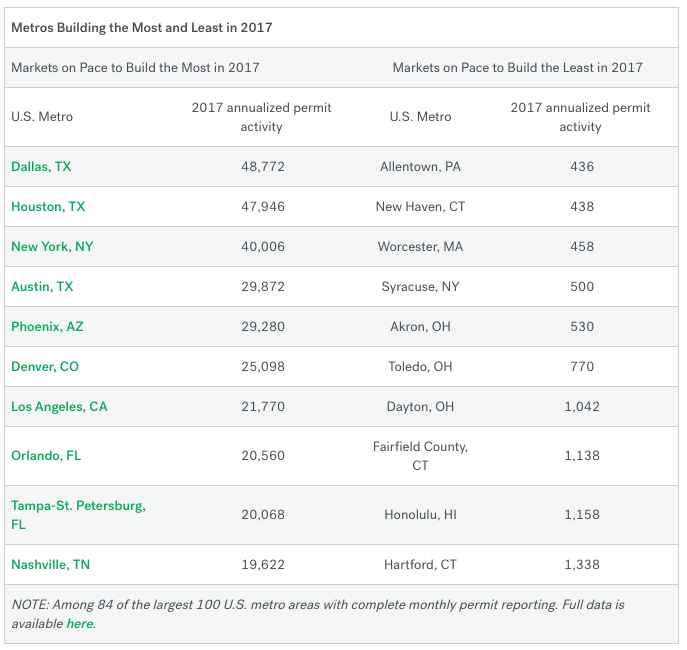Texas’ inventory shortages won’t be around much longer if the state keeps up its crazy-fast homebuilding pace. The state is currently blowing past the rest of the country in homebuilding, with only three Texas markets – Dallas, Houston, and Austin – on pace to make up more than 10% of all permits in the U.S.
That’s a lot of new homes.
According to a new report from Trulia that breaks down the nation’s homebuilding numbers, the three cities are on pace to build nearly 130,000 new homes in 2017. The permits for the three cities make up nearly as much as 50 other large U.S. metros combined.
The chart below from Trulia compares the three Texas housing markets to other top metros.
Ralph McLaughlin, Trulia chief economist, explained what the growth means for the cities, stating, “We think the building boom in Austin and Dallas is healthy and welcomed, given the meteoric rise in prices and decrease in affordability we’ve seen over the past year. Massive homebuilding in Houston, on the other hand, may exacerbate the recent cooling in home prices.”
“We can’t say for certain, but at this pace, we would expect new housing construction at these high levels to make a noticeable increase on existing inventory in one to two years in constrained Austin and Dallas, and maybe less in a cooling Houston market,” said McLaughlin.
This is welcomed news for the state since, much like the rest of the country, it has been struggling with a lack of housing inventory.
Earlier this year, the Texas Association of Realtors forecasted that Texas housing in 2017 wouldn’t be quite as rosy as the previous years, due to decreasing inventory, as well as those rising prices, and the state’s rapidly rising property taxes, which are significantly impacting affordability in the state.
But looking at this new Trulia report, things are starting to look up for the state. When it comes to sheer homebuilding activity, the Dallas and Houston metro areas are the top contenders to win this year’s homebuilding gold medal, Trulia stated.
Dallas is the No. 1 homebuilding market in the country, with nearly 49,000 projected permits. Houston is a close second at nearly 48,000 permits.
Texas, of course, isn’t alone in trying to solve the death of available inventory in the country. New York rounded out the top three, with a projection of just over 40,000.
The chart below tracks the metros expected to build the most and least in 2017.
Click to enlarge
(Source: Trulia)
But, since the top three metros do have an advantage since they’re simply larger, Trulia also pulled the data to see where homebuilding activity is booming relative to historic norms. In this situation, Austin, Texas, Charleston, South Carolina, and Nashville are on track to finish the year with most activity.
Trulia found that the three cities are on track to finish 2017 having approved 107.7%, 72.8%, and 65.8%, respectively, more residential construction than their historic average.
So what’s causing all the growth? The report pinpointed the three main reasons why is homebuilding booming.
1. Job growth: Jobs provide a steady source of income that lenders usually require as a condition of financing. So, more jobs lead to more demand for homes, which in turn supports new homebuilding activity.
2. Income growth: Even after taking into account the impact of job growth, income growth also helps bolster homebuilding. This is likely for two reasons: (1) housing is a normal good, which means as people earn more money they tend to buy more or better quality homes, and (2) new homes are more expensive than existing ones, so gains in income might allow existing homeowners to trade up to new homes.
3. Home price appreciation: Price appreciation is important because of the law of supply: as the price of goods increase, suppliers will tend to supply more of it.
For the Texas boom specifically, McLaughlin added, “Texas has the right mix of conditions to support a homebuilding boom: a glut of flat developable land, a business-friendly regulatory environment, strong job growth, and good weather.”

